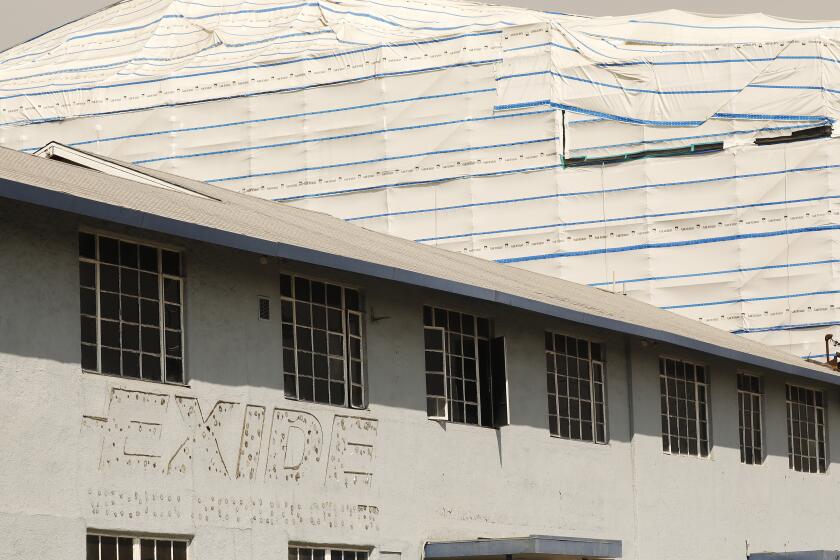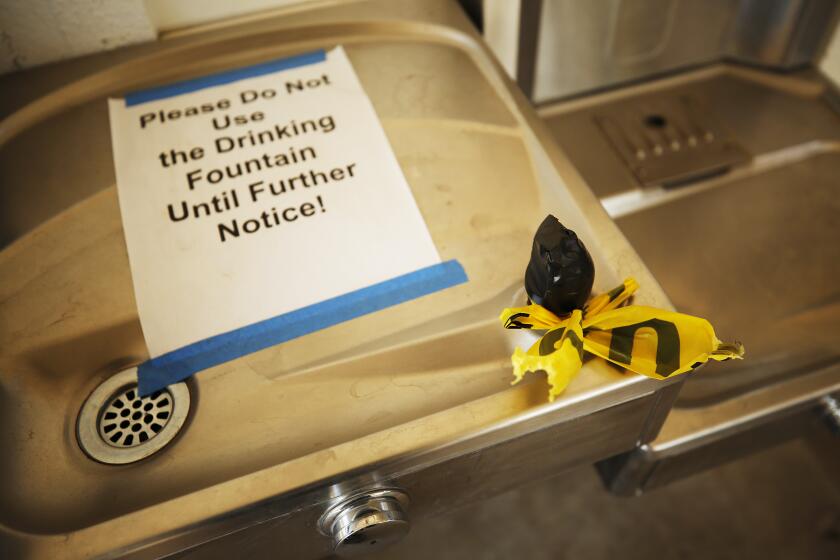California needs more than just money to stop bungling the Exide cleanup

- Share via
It’s about time. After years of being excluded from California’s largest environmental cleanup, there’s finally a proposal to remove lead-tainted soil from thousands of parkways — the publicly owned strips of land between people’s homes and the street — in neighborhoods around the abandoned Exide battery recycling plant.
Gov. Gavin Newsom’s revised budget proposal includes $67.3 million for removing lead contamination from parkways in the southeast L.A. County cleanup zone. It’s a welcome, if late, step to address a hazard state officials have neglected that still threatens thousands of residents, especially children, who are most harmed by the brain-damaging metal.
A Department of Toxic Substances Control spokesperson said the state’s objective is to clean 6,425 parkways with lead concentrations above the state health standard of 80 parts per million by 2027 “or sooner, assuming no unanticipated delays.”
But throwing more money at what is already the state’s largest and most expensive environmental cleanup isn’t enough. There needs to be more oversight, including independent, third-party monitoring, to keep the department on track and ensure it does not keep bungling the $750-million cleanup.
A Times investigation raises more questions about whether state regulators are up to the task of the $750-million Exide lead cleanup in L.A. County.
It’s worth remembering state regulators’ shameful and infuriating history of mismanagement and neglect, including allowing Exide to operate the car battery recycling facility without a full permit for decades, and once it was shut down, proceeding at a glacial pace to clean homes riddled with lead contamination.
Concerns about the quality of the state-led cleanup were renewed recently when a Times investigation revealed that dozens of homes that were supposedly cleaned were later found to have lead concentrations above health standards; contractors failed to meet state soil-removal guidelines at more than 500 of 3,370 cleaned properties.
In another story, Times journalists Tony Briscoe and Jessica Garrison reported that the Department of Toxic Substances Control forfeited millions of dollars that were set aside to remove lead contamination from parkways after it failed to devise a cleanup plan and missed a deadline to spend the money.
“The fact that they could just sit on all that money and not clean up our communities, it felt like a big betrayal,” said mark! Lopez with East Yard Communities for Environmental Justice.
“Our communities have been fighting Exide for 30 years and cleaning up contaminated parkways has been part of our demands since the state confirmed our homes are contaminated almost a decade ago,” Lopez said.
Children in many California schools may to exposed to lead in water fountains unless school districts conduct widespread testing and, if needed, clean up.
The funding proposal comes after state Assemblymember Wendy Carrillo (D-Los Angeles) and half a dozen other legislators wrote the department requesting to use fees the state already collects on lead-acid car batteries like the ones melted down for decades at the Exide plant to pay for the parkway cleanup.
Although it’s good that the state is putting up the money necessary to clean up the parkways and protect residents, it would be malpractice for lawmakers to give the Department of Toxic Substances Control more funding without significant oversight requirements.
Case in point: A department spokesperson would not answer questions about whether the department is doing anything to improve oversight of the project, the funds paying for it and contractors carrying it out.
Community groups, with good reason, have for years now demanded stronger accountability measures to ensure the department delivers the cleanup to the standards and timeline promised. They have called for third-party monitoring, which seems like a wise request. Generations of people in southeast L.A. County have suffered the health effects of the facility’s pollution, and from government inaction in addressing it. It should be clear by now that we need more people looking over state regulators’ shoulders to make sure the soil cleanups are done right.
New York just became the first state to ban gas hookups from new buildings to fight climate change and air pollution. What’s preventing California from doing the same?
California has already spent hundreds of millions of dollars cleaning up the mess left behind by Exide, which was allowed by a bankruptcy court to abandon the plant and leave state taxpayers with the cleanup bill.
Department director Meredith Williams and other top officials have vowed to improve their communication with residents in the cleanup zone, and community leaders say they are now meeting with state officials about the project on a weekly basis.
That’s encouraging.
Department officials have a lot of work ahead to fulfill the state’s cleanup pledges and rebuild trust with the community. The Newsom administration and lawmakers can start to help by requiring independent oversight to ensure the cleanup of the parkways is completed on time and to the highest possible standards.
More to Read
A cure for the common opinion
Get thought-provoking perspectives with our weekly newsletter.
You may occasionally receive promotional content from the Los Angeles Times.












